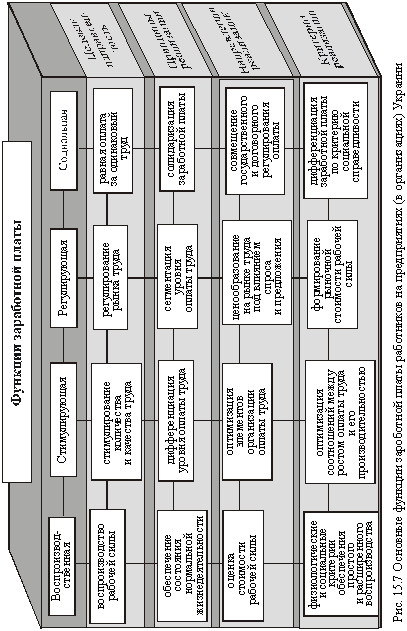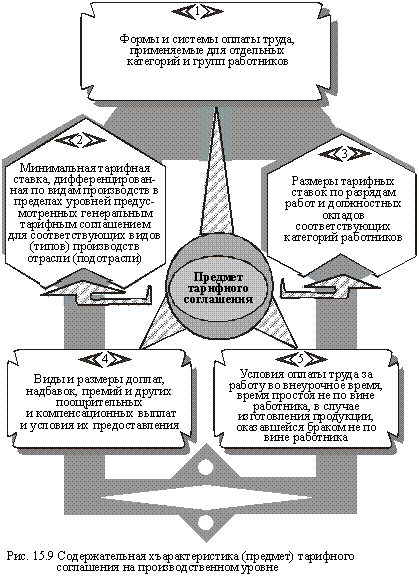home
 Economy Economy
 Business Economics - Pokropivny SF Business Economics - Pokropivny SF
|
Business Economics - Pokropivny SF
15.3. Modern wage policy
The concept and function
Efficiency of functioning and social development of those or other entities (labor groups) provided primarily the formation of adequate individual and collective material incentives? leading form the implementation of which is the wages of different categories of personnel.
Wages - is any income, calculated, usually in monetary terms, which in the labor contract owner or its authorized body shall pay the employee for manufactured goods (works, services rendered)
It consists of a basic salary and additional pay. Dimensions employee payment depends on the results of his work in the light of the overall economic activity of the enterprise.
The basic salary of an employee is determined by the specific tariff rates, piece-rates, official salaries and allowances, and a supplement of not satiate established by the current legislation in the country. The level of additional remuneration in most cases, depends on the outcome of the enterprise. Usually extra pay include bonuses and other incentive and compensation payments, as well as allowances and additional payments not provided for by applicable law or specified size over which they are allowed. According to calculations in the industrial enterprises in Ukraine over the past few years, the basic salary and additional pay are, respectively, 70-80 and 20-30% of the total earnings.
With the development of entrepreneurship and the existence of various forms of ownership employee salary is not determined by the size of the guaranteed wage fund, and all the more dependent on the outcomes of activities and income of the enterprise. Keep in mind that the worker is increasingly becoming more or less than the real owner of the company. Therefore, (co-founder), rewarding the worker-owner, a certain income necessary to charge not only for work, but also invested in venture capital. Given the changes in the nature and mechanism of formation of earnings of the employee, rather than the concept of "wages" more and more often use the terms "labor income", "award", "pay", "income", "income". But in any case the total compensation (monetary or non-monetary, sometimes mixed) for the spent efforts, including salaries should reflect the contribution of each employee to the common cause, the effectiveness of its work.
The effectiveness of the wage is determined by how well it performs its basic functions - reproductive, stimulating, regulatory and social. Moreover, the terms of each individual structural wage functions reflect specific aspects of the problem: target orientation, principles, directions and performance criteria (Figure 15.7.).
The implementation of the reproductive function of wages provides for the establishment of wage standards at a level that ensures the normal reproduction of labor power and the appropriate qualifications at the same time allows the use of reasonable labor standards that guarantee the owner to obtain necessary result of economic activity. Stimulation function is to ensure that a possible wage level should encourage each employee to the most effective actions in the workplace. Regulatory wage obscheupotreblyaemy function implements the principle of differentiation of the level of earnings in accordance with the specialty and qualification of personnel, the importance and complexity of work tasks. The social function of wages is aimed at ensuring equal pay for equal work; it must combine public and contract its regulation, as well as to implement the principle of social justice in relation to the preparation of their own income.

Modern politics
Full and effective implementation of the main functions of a payment is only possible on condition of formation and the consistent implementation of evidence-based policies such as the payment at the macro level (government, industry, region) as well as at the micro level (enterprise, organization, their division).
Public wage policy is practically implemented as part of a general mechanism for the implementation of socio-economic policy of the state (Fig. 15.8).
Using the specific levers of the mechanism of state regulation of remuneration depends on various factors.
In particular, the minimization of wage adjusted according to the level of economic development, labor productivity, average wages and the cost of the value of the minimum consumer budget ( "basket"). To this we must add that the practical importance is the full realization of information functions of the state, ie, the timely preparation and publication of statistical data: quarterly - on average wages and hours of work by industry, groups of professions and positions;.. annually - about labor costs in accordance with the standard international classification of labor costs.
The wage policy of enterprises, organizations and other primary business entities formed and implemented within the existing legislation - particularly the Law of Ukraine "On wage" (1995). It must take into account the strategic and tactical objectives of the specific entities and their industry-specific, absolute size, geographical location, the degree of international integration, the level of social development of the team and so on. N.

The specific implementation of the wage policy is carried out on the basis of an agreement on the regulation of the labor of hired employees payment, ie on the basis of the conclusion of collective agreements on three levels..:
- interbranch (general collective agreement);
- sectoral or municipal (or branch or regional collective agreements);
- production (collective agreement as part of the collective agreement).
Tariff Agreement - a contract between the parties on the issues of remuneration and social guarantees. It is at every level has a specific substantive response. In particular, the subject of the tariff on the production level agreements (as part of the collective agreement) are structural elements in Fig. 15.9.
In the case of hiring an employee under contract owner or its authorized body may establish (with the consent of the employee) as the collective agreement provided for, and individual conditions of payment.
It will be appreciated that the rate of production of the tariff level agreements may temporarily (up to 6 months) to allow wage levels, lower than the norm, certain general sectoral or regional agreements, but not below the state standards and guarantees for payment.
During the action (period of negotiations between the parties) tariff agreements none of the representatives of the Parties to the scope of these agreements can not require a one-sided increase (decrease) in wages and benefits reconciled as provided tariff agreement.

Fundamentals of
Practical wage organization is based on public and contractual regulation of its absolute level and mechanism for determining the individual salaries of all categories of workers (workers, professionals, employees, managers) of enterprises and institutions of different ownership forms. The main organizational and legal instrument justify differentiation of wages of workers of different entities (activity) is tariff-TOR system, including such structural elements: the tariff-qualifying directories: Qualification schedule of managers, specialists and employees; grid tariff and rates; salary scheme or a single tariff scale.
Tariff-qualifying directories in a single tariff-qualifying directory of works and trades workers (ETCS) - a collection of regulations, which contains the qualification characteristics of jobs and professions, grouped by industries and types of work. ETCS is designed for charging works, assigning qualification ranks workers, as well as for the formation of curriculum development and training of employees.
Qualification schedule of managers and employees are normative documents, which are given sectoral qualification characteristics of these categories of workers. They contain the duties, requirements for knowledge and professional experience, level and profile training of managers, professionals and employees.
Tariff grid sets the appropriate ratio of wage workers with different skills. It is, in fact, the list of tariff categories and their corresponding payment rates. Installed in Ukraine tariff system parameters are given in Table. 15.1.
Table 15.1
STANDARD TARIFF GRID raznootraslevyh BUSINESS ENTERPRISES AND ORGANIZATIONS
| Indicators | wage category |
|||||||
1 |
2 |
3 |
4 |
5 |
6 |
7 |
8 |
|
Tariff rates |
1.0 |
1,088 |
1,024 |
1,350 |
1,531 |
1,800 |
1,892 |
2.0 |
|
Growth of tariff coefficients
|
x x |
0.088 8.8 |
0,116 10.7 |
0.146 12.1 |
0,181 13.4 |
0.269 17.6 |
0,092 5.1 |
0,108 5.7 |
The tariff rate of the first category is always equal to one. In the first category are billed simple operation, the implementation of which does not require training. Odds subsequent bits characterize the degree of difficulty of workers having such discharges.
An important element of the tariff system is a flat rate. Its absolute value is determined in accordance with the established state the minimum wage, that is so below which can not be made to pay the employee for the work time rate. To this we must add that the minimum wage does not include bonuses, allowances and compensation payments. Therefore, wage can not be below the state minimum wage worker, even at default of production standards, or the manufacture of defective products.
Remuneration of managers, professionals and employees of specific entities established by the state is carried out by the official salary by reference to the system of incentives for high performance work or the contract (contract) system denationalized enterprises (organizations) and other business and commercial structures.


Comments
Commenting, keep in mind that the content and the tone of your messages can hurt the feelings of real people, show respect and tolerance to his interlocutors, even if you do not share their opinion, your behavior in terms of freedom of speech and anonymity offered by the Internet, is changing not only virtual, but real world. All comments are hidden from the index, spam control.